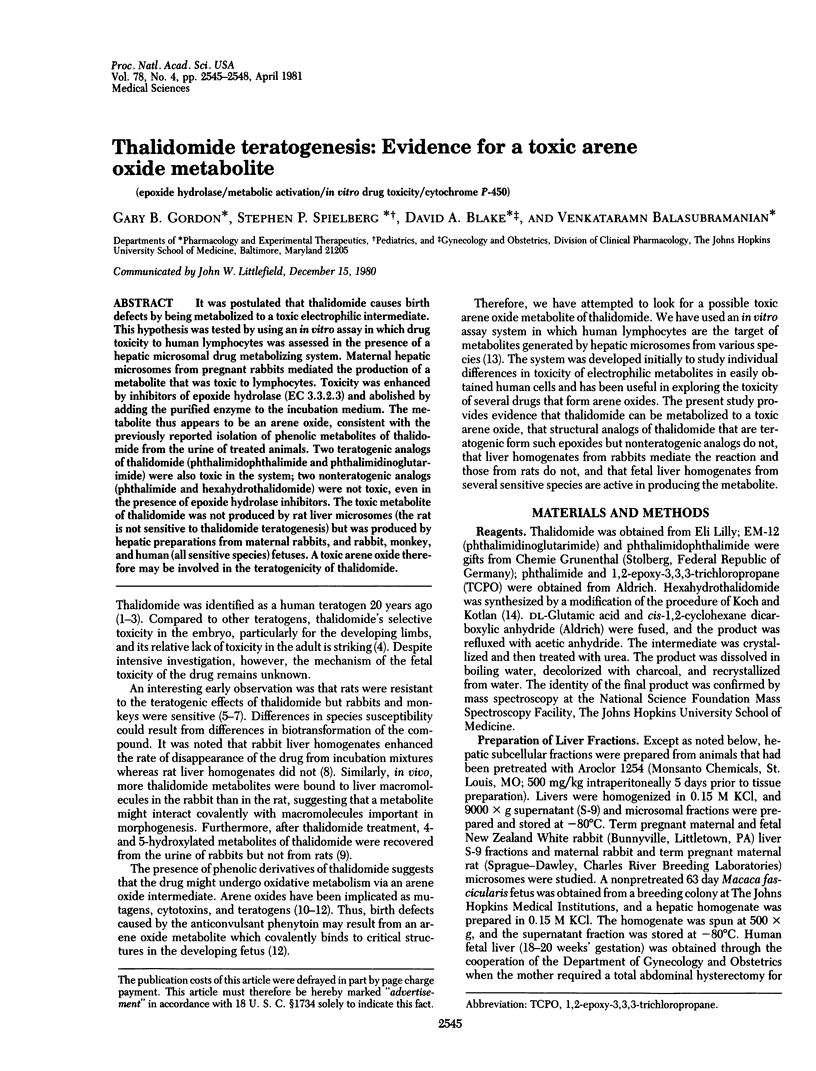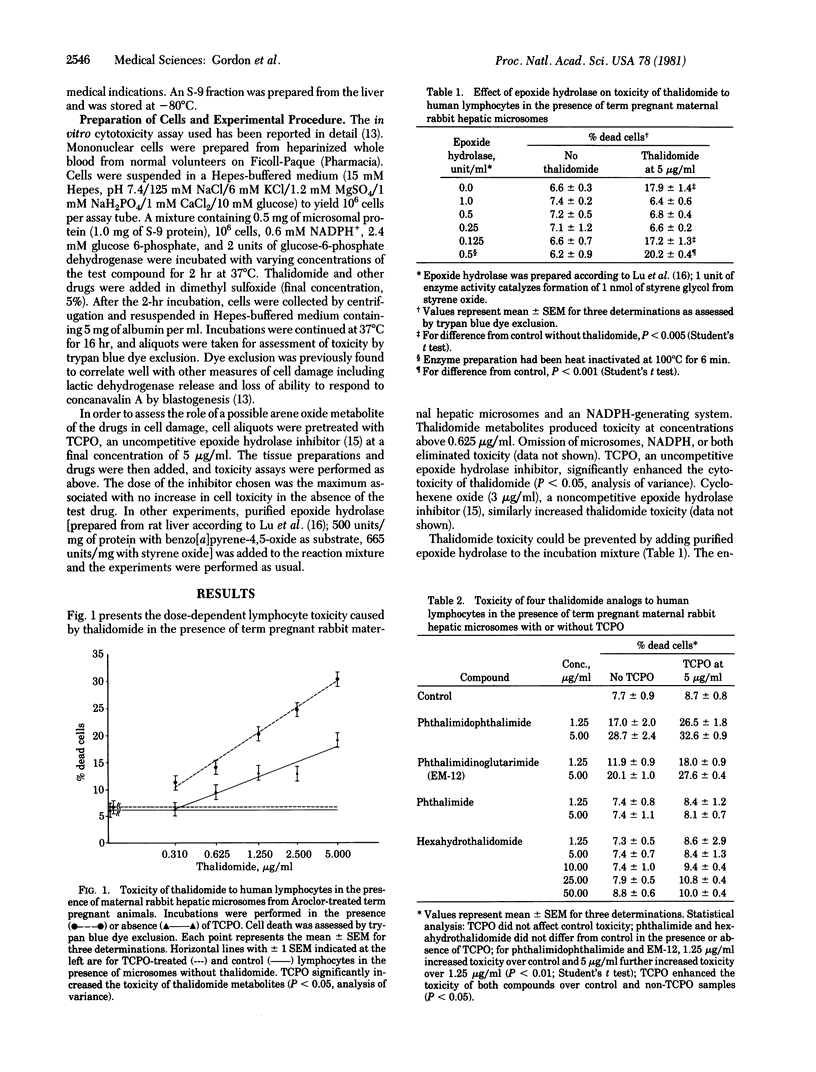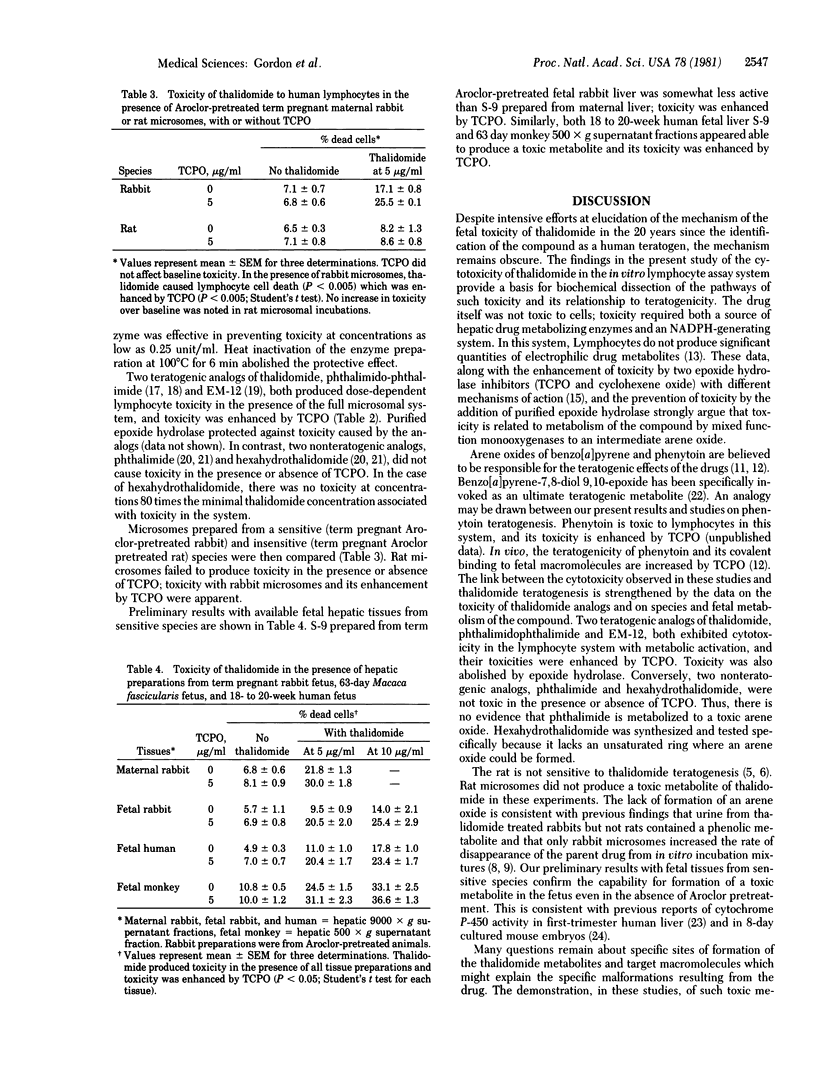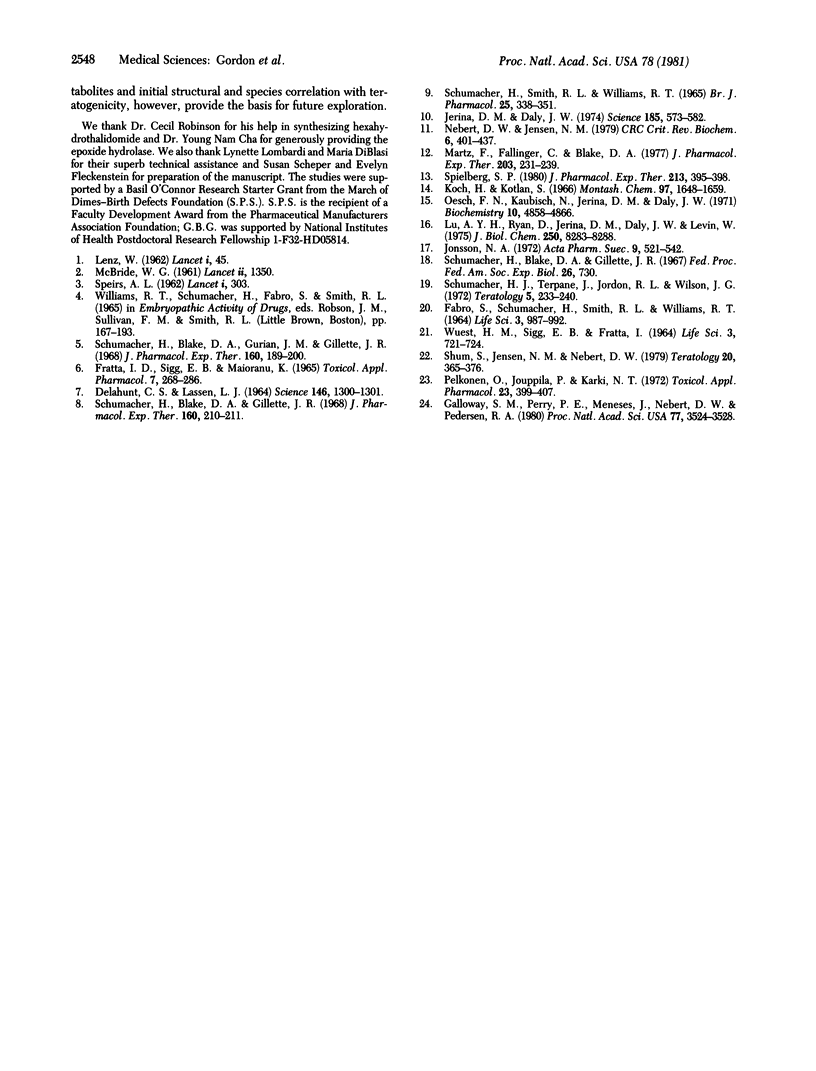Abstract
It was postulated that thalidomide causes birth defects by being metabolized to a toxic electrophilic intermediate. This hypothesis was tested by using an in vitro assay in which drug toxicity to human lymphocytes was assessed in the presence of a hepatic microsomal drug metabolizing system. Maternal hepatic microsomes from pregnant rabbits mediated the production of a metabolite that was toxic to lymphocytes. Toxicity was enhanced by inhibitors of epoxide hydrolase (EC 3.3.2.3) and abolished by adding the purified enzyme to the incubation medium. The metabolite thus appears to be in arene oxide, consistent with the previously reported isolation of phenolic metabolites of thalidomide from the urine of treated animals. Two teratogenic analogs of thalidomide (phthalimidophthalimide and phthalimidinoglutarimide) were also toxic in the system; two nonteratogenic analogs (phthalimide and hexahydrothalidomide) were not toxic, even in the presence of epoxide hydrolase inhibitors. The toxic metabolite of thalidomide was not produced by rat liver microsomes (the rat is not sensitive to thalidomide teratogenesis) but was produced by hepatic preparations from maternal rabbits, and rabbit, monkey, and human (all sensitive species) fetuses. A toxic arene oxide therefore may be involved in the teratogenicity of thalidomide.
Full text
PDF



Selected References
These references are in PubMed. This may not be the complete list of references from this article.
- DELAHUNT C. S., LASSEN L. J. THALIDOMIDE SYNDROME IN MONKEYS. Science. 1964 Dec 4;146(3649):1300–1305. doi: 10.1126/science.146.3649.1300. [DOI] [PubMed] [Google Scholar]
- FABRO S., SCHUMACHER H., SMITH R. L., WILLIAMS R. T. TERATOGENIC ACTIVITY OF THALIDOMIDE AND RELATED COMPOUNDS. Life Sci. 1964 Sep;3:987–992. doi: 10.1016/0024-3205(64)90109-2. [DOI] [PubMed] [Google Scholar]
- FRATTA I. D., SIGG E. B., MAIORANA K. TERATOGENIC EFFECTS OF THALIDOMIDE IN RABBITS, RATS, HAMSTERS, AND MICE. Toxicol Appl Pharmacol. 1965 Mar;7:268–286. doi: 10.1016/0041-008x(65)90095-5. [DOI] [PubMed] [Google Scholar]
- Galloway S. M., Perry P. E., Meneses J., Nebert D. W., Pedersen R. A. Cultured mouse embryos metabolize benzo[a]pyrene during early gestation: genetic differences detectable by sister chromatid exchange. Proc Natl Acad Sci U S A. 1980 Jun;77(6):3524–3528. doi: 10.1073/pnas.77.6.3524. [DOI] [PMC free article] [PubMed] [Google Scholar]
- Jerina D. M., Daly J. W. Arene oxides: a new aspect of drug metabolism. Science. 1974 Aug 16;185(4151):573–582. doi: 10.1126/science.185.4151.573. [DOI] [PubMed] [Google Scholar]
- Jönsson N. A. Chemical structure and teratogenic properties. 3. A review of available data on structure-activity relationships and mechanism of action of thalidomide analogues. Acta Pharm Suec. 1972 Dec;9(6):521–542. [PubMed] [Google Scholar]
- Lu A. Y., Ryan D., Jerina D. M., Daly J. W., Levin W. Liver microsomal expoxide hydrase. Solubilization, purification, and characterization. J Biol Chem. 1975 Oct 25;250(20):8283–8288. [PubMed] [Google Scholar]
- Martz F., Failinger C., 3rd, Blake D. A. Phenytoin teratogenesis: correlation between embryopathic effect and covalent binding of putative arene oxide metabolite in gestational tissue. J Pharmacol Exp Ther. 1977 Oct;203(1):231–239. [PubMed] [Google Scholar]
- Nebert D. W., Jensen N. M. The Ah locus: genetic regulation of the metabolism of carcinogens, drugs, and other environmental chemicals by cytochrome P-450-mediated monooxygenases. CRC Crit Rev Biochem. 1979;6(4):401–437. doi: 10.3109/10409237909105427. [DOI] [PubMed] [Google Scholar]
- Oesch F., Kaubisch N., Jerina D. M., Daly J. W. Hepatic epoxide hydrase. Structure-activity relationships for substrates and inhibitors. Biochemistry. 1971 Dec 21;10(26):4858–4866. doi: 10.1021/bi00802a005. [DOI] [PubMed] [Google Scholar]
- Pelkonen O., Jouppila P., Kärki N. T. Effect of maternal cigarette smoking on 3,4-benzpyrene and N-methylaniline metabolism in human fetal liver and placenta. Toxicol Appl Pharmacol. 1972 Nov;23(3):399–407. doi: 10.1016/0041-008x(72)90042-7. [DOI] [PubMed] [Google Scholar]
- SPEIRS A. L. Thalidomide and congenital abnormalities. Lancet. 1962 Feb 10;1(7224):303–305. doi: 10.1016/s0140-6736(62)91248-5. [DOI] [PubMed] [Google Scholar]
- Schumacher H. J., Terapane J., Jordan R. L., Wilson J. G. The teratogenic activity of a thalidomide analogue, EM 12 in rabbits, rats, and monkeys. Teratology. 1972 Apr;5(2):233–240. doi: 10.1002/tera.1420050213. [DOI] [PubMed] [Google Scholar]
- Schumacher H., Blake D. A., Gillette J. R. Disposition of thalidomide in rabbits and rats. J Pharmacol Exp Ther. 1968 Mar;160(1):201–211. [PubMed] [Google Scholar]
- Schumacher H., Blake D. A., Gurian J. M., Gillette J. R. A comparison of the teratogenic activity of thalidomide in rabbits and rats. J Pharmacol Exp Ther. 1968 Mar;160(1):189–200. [PubMed] [Google Scholar]
- Schumacher H., Smith R. L., Williams R. T. The metabolism of thalidomide: the fate of thalidomide and some of its hydrolysis products in various species. Br J Pharmacol Chemother. 1965 Oct;25(2):338–351. doi: 10.1111/j.1476-5381.1965.tb02054.x. [DOI] [PMC free article] [PubMed] [Google Scholar]
- Shum S., Jensen N. M., Nebert D. W. The murine Ah locus: in utero toxicity and teratogenesis associated with genetic differences in benzo[a]pyrene metabolism. Teratology. 1979 Dec;20(3):365–376. doi: 10.1002/tera.1420200307. [DOI] [PubMed] [Google Scholar]
- Spielberg S. P. Acetaminophen toxicity in human lymphocytes in vitro. J Pharmacol Exp Ther. 1980 May;213(2):395–398. [PubMed] [Google Scholar]
- WUEST H. M., SIGG E. B., FRATTA I. PHARMACOLOGICAL PROPERTIES AND TERATOGENIC ACTION OF 2-(HEXAHYDROPHTHALIMIDO) GLUTARIMIDE AND 2-PHTHALIMIDO-N-METHYLGLUTARIMIDE. Life Sci. 1964 Jul;3:721–724. doi: 10.1016/0024-3205(64)90025-6. [DOI] [PubMed] [Google Scholar]


